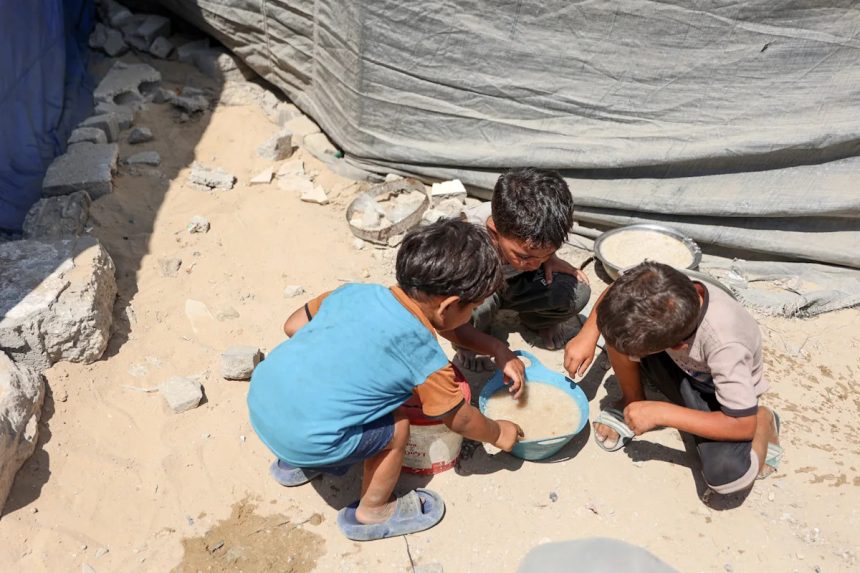Gaza faces a grave risk of famine, with one in three people going days without food, the UN Children’s Fund (UNICEF) has warned.
UNICEF on Friday urged the international community to act swiftly as conditions continue to deteriorate due to Israel’s genocidal war.
“Today, more than 320,000 young children are at risk of acute malnutrition,” Ted Chaiban, UNICEF’s deputy executive director for humanitarian action and supply operations, said in a statement on Friday following a recent trip to Israel, Gaza and the occupied West Bank.
He said the malnutrition indicator in Gaza has “exceeded the famine threshold”.
“Today, I want to keep the focus on Gaza, because it’s in Gaza where the suffering is most acute and where children are dying at an unprecedented rate,” he said.
“We are at a crossroads, and the choices made now will determine whether tens of thousands of children live or die.”
On Saturday, Atef Abu Khater, a 17-year-old Palestinian, died of malnutrition, a medical source at al-Shifa Hospital told Al Jazeera.
Earlier this week, Khater, who had been in good health before the war in Gaza, was hospitalised in intensive care, according to media reports, which quoted his father as saying he was no longer responding to treatment.
Since October 7, 2023, Israel’s war on Gaza has killed at least 60,000 Palestinians, more than 18,000 of them children. Many more remain buried under the rubble, most presumed dead.
According to Gaza’s Ministry of Health, the number of deaths from starvation in the territory stands at 162, including 92 children.
‘Engineered Israeli genocidal chaos’
Ahmed al-Najjar, a journalist and resident of Gaza who is sheltering in Khan Younis, says Palestinians in the besieged territory are faced with “tragedy and torment” amid Israeli bombardment, forced starvation and a complete feeling of insecurity.
“With the cats away, the mice will play – except that it’s not just a mouse, but an engineered Israeli genocidal chaos,” he told Al Jazeera, stressing that safety is “nowhere to be found” in Gaza.
“We are not just referring to the fact of constant fear of the Israeli bombs being dropped on our heads, but the fact that there is a total security and power vacuum that leaves us here unsure and uncertain of our own safety,” al-Najjar said.
He described that even walking in the street and going to buy a bag of flour or some other basic necessity makes people feel uncertain whether they will be able to return home safely.
“There is not any sort of presence of police or security forces in the streets; we’ve been seeing the continuous and systematic targeting of the police forces inside these ‘safe zones’ here.”
(Al Jazeera)
In March, Israel blocked food aid from entering Gaza. It eased the blockade in late May, after which the controversial Israel- and United States-backed GHF took over aid distribution in Gaza.
But GHF has been accused of grave rights violations and the targeting of civilians. The UN says more than 1,300 Palestinians have been killed trying to get food from the GHF’s aid hubs.
Many have been purposefully shot by Israeli soldiers or US security contractors hired by GHF, according to testimonies from whistleblowers published in the media.
With starvation across the Strip spreading, international outcry over images of emaciated children and increasing reports of hunger-related deaths pressured Israel to let more aid into the Gaza Strip earlier this week.
The Israeli military last week began a daily “tactical pause” of its military operations in parts of Gaza and established new aid corridors.
US President Donald Trump’s special envoy, Steve Witkoff, also travelled to Gaza on Friday to inspect the GHF aid distribution site, together with Mike Huckabee, the US ambassador to Israel.
The diplomats “spent over five hours inside Gaza”, Witkoff said in a post on X, accompanied by a photo of himself wearing a protective vest and meeting staff at a distribution site.
He added that the purpose of the trip was to “help craft a plan to deliver food and medical aid to the people of Gaza”.
Meanwhile, several Western and Arab governments began carrying out aid airdrops in Gaza earlier this week, to feed more than two million inhabitants. But aid agencies have said they are deeply sceptical that airdrops could deliver enough food safely to tackle a deepening hunger crisis in Gaza.
“Look, at this stage, every modality needs to be used, every gate, every route, every modality, but airdrops cannot replace the volume and the scale that convoys by road can achieve,” Chaiban said, adding that allowing about 500 humanitarian and commercial aid trucks into Gaza is important.
He also noted that what is happening on the ground is “inhumane” and stressed that “what children in Gaza need from all communities is a sustained ceasefire and a political way forward.”









